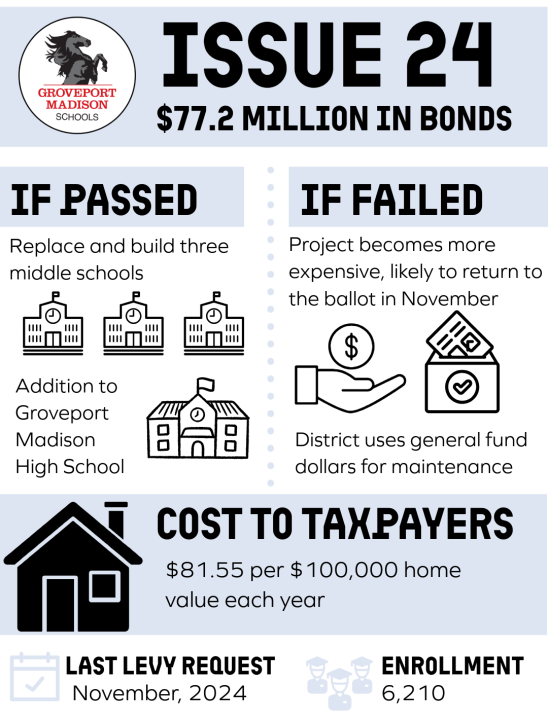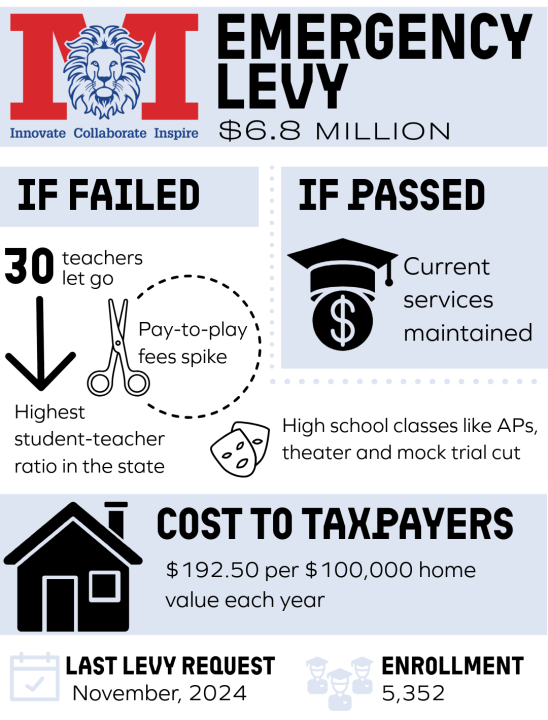COLUMBUS, Ohio (WCMH) — Ohio school districts are hoping to find success at the ballot Tuesday, when voters will decide the fate of several school bond issues or levies.
Many funding requests stem from increasing enrollment as central Ohio’s population grows. Funds would help districts afford building renovations and expansions, or just allow them keep operating. Ohio public schools are facing potential funding cuts from the state, making ballot requests all the more crucial.
Here are the levy and bond issues you can expect on your ballot May 6.
Groveport Madison — Issue 24
Just six months after voters rejected a district levy, Groveport residents will vote on school funding once more. If passed, Issue 24 would generate $77.2 million for the district, which it would use to construct three new middle schools and expand Groveport Madison High School. See previous coverage of Issue 24 in the video player above.

The district said the bond issue would help fund crucial improvements to district facilities. The district fears its current facilities will not suffice as enrollment increases, with the student body predicted to increase by more than 620 students over the next 10 years.
Further, the district said new middle schools are needed to replace the current open floor plan buildings, which raise safety concerns and are often distracting.
The issue would cost taxpayers $81.55 per $100,000 of their home value annually, a less than $3 decrease from the levy that failed last November. Residents against the levy told NBC4 they worry the district is not spending money responsibly and that they cannot afford higher taxes. Residents in favor of the levy said it is important to support students.
Marysville Exempted Village — Emergency levy
For the third time, Marysville is requesting community help with an emergency levy, a last chance to avoid major budget cuts. The 5.5 mills emergency operating levy would generate $6.8 million and allow the district to keep up with day-to-day operations.
The last two levies Marysville put on the ballot failed, and the district will have to cut 30 teachers and a number of classes if this one fails as well.
The district has not passed a levy in 17 years and is now entering a deficit, so it is spending more than it is bringing in. The district said it has already cut spending by more than $2 million, and any further cuts will dramatically change the district’s makeup.

The emergency levy would cost taxpayers $192.50 per $100,000 of their home’s value each year. Parents in favor of the levy told NBC4 their children are devastated about possible cuts impacting their favorite students and teachers. Other residents said they simply can’t afford higher property taxes.
Jonathan Alder — Bond issue, 5.12 mills
Jonathan Alder Local Schools are requesting a 5.12 mills bond issue that would generate around $70.6 million for the district. If passed, the district would use the money to fund its facilities master plan.
The plan involves renovating district buildings and constructing a new high school and junior high. Jonathan Alder leadership said enrollment is increasing, with its 2,300 total enrollment predicted to grow by 385 students over the next ten years. The district is hoping to bring each school building to 80% capacity in order to prepare for growth and better distribute district resources.
The bond issue would cost most residents $179 per $100,000 of their home value per year. However, residents on land that qualifies for current agricultural use valuation (CAUV) will pay less on their land. CAUV residents will owe $5.22 per acre. If the issue does not pass, the Board of Education will consider another bond issue request, although costs will likely increase the longer it takes to pass.
Southwest Licking — Bond issue, 4.2 mills
Southwest Licking has a $115 million bond issue on the ballot this May. If passed, it would fund a new fifth- and sixth-grade middle school, a high school expansion and The Spear, a training facility and aquatic center.
The renovations were developed by a team of parents, community members and district representatives and would cost about $115 million in total. Although the district has new buildings thanks to a 2017 partnership with the state, district representatives said state officials did not consider Southwest Licking’s enrollment projections, so the schools are ill-equipped to handle increasing enrollment. The Spear training facility will be built in collaboration with the YMCA and offer amenities for students and community members.
The bond issue would cost taxpayers $147 per $100,000 of their home’s value each year. Parents in favor of the bond issue said costs will only increase overtime, and the funding is needed to address growing enrollment. Those against the issue said the cost of the taxes would be especially difficult for retired community members, and they don’t feel the cost is worth it.
Teays Valley — Bond issue, 3.26 mills
Teays Valley Local Schools are requesting a 3.26 mills bond issue to help build new schools. If passed, the issue would generate $64.39 million over 37 years to fund two new intermediate schools.
The district projects enrollment will increase by 1,000 students over the next 10 years, a significant increase to its current 4,420-member student body. The district said three elementary or middle schools are already at or over capacity, and the district has already spend $650,000 on overflow classrooms. The expansion would allow them to reconfigure their schools to address enrollment.
If voters approve the bond issue, it will cost taxpayers $52.50 annually per $100,000 of their home’s value. The district said without bond issue funds, overflow classrooms costs could total more than $20 million over the next 10 years, and overcrowding will put pressure on the district’s resources and learning environment.










